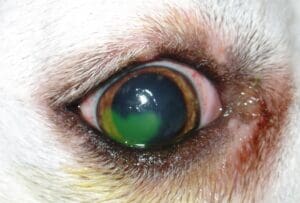AUGUST
The cornea is the clear outer layer at the front of the eye that serves as a protective barrier against dirt, germs, and other damaging particles. There are three layers in the cornea, all of which are made up of highly specialized skin cells. The outermost layer is the epithelium which is an important component of corneal ulcers.
A corneal ulcer is an abrasion or wound to the pet’s corneal surface that causes a break in the epithelium. The most common cause of an ulcer is by a traumatic injury. This may be blunt trauma, such as the pet rubbing its eye on the carpet, acute trauma, a scratch or laceration with a sharp object/foreign material. Trauma may also be caused from chronic irritation from eyelids rolling inward or an abnormal eyelash. Another cause is chemical burn to the cornea. This may be due to an irritating chemical or substance entering the eye such as pet shampoo. Less common causes of corneal ulcers include bacterial and/or viral infections, as well as some other secondary diseases.
A corneal ulcer is very painful for the pet. They might rub their face on the carpet and/or with their paw, squint, or hold eye completely shut, and have excessive drainage from that eye. The drainage will either collect in the corner of the eye or run down the face. There may also be a color to the discharge; green/yellow if infected, or gray to white to clear.

Most corneal ulcers are classified as simple ulcers, meaning they affect only the superficial corneal layers, and will heal with prompt veterinary care. Corneal ulcers are detected with the use of a special stain called fluorescein. A drop of this stain is placed on the cornea. If there is a disruption to the epithelium, the stain will turn green and adhere to the underlying tissue. A special blue light will help the stain to glow a neon green color and identify an ulcer.
Treatment depends on severity of the ulcer. Most ulcers will heal with an antibiotic ointment or solution, but must be applied frequently (as directed by your veterinarian). Oral pain medications may also be prescribed to help with discomfort and inflammation. If the ulcer is from a lack of tear production, known as keratoconjunctivitis sicca, an artificial tear ointment or tear stimulants may be prescribed. In some cases, blood is drawn from the pet and turned into a serum which acts as a “liquid bandage” to help stimulate healing.
In all cases, a corneal ulcer requires frequent rechecks with a veterinarian to determine healing progress and changes in treatment if needed.
Article written by: Lindsey G.
1 Image taken from commons.wikimedia.org. Used under the Creative Commons Attribution-Share Alike 3.0 Unported license. No changes made.